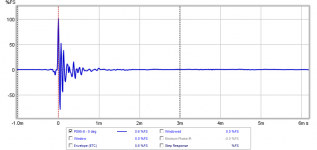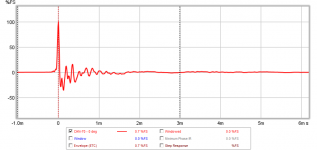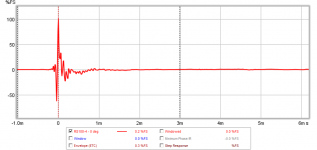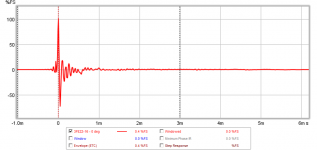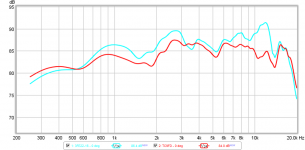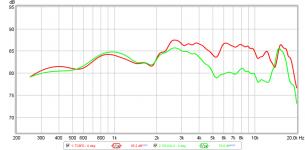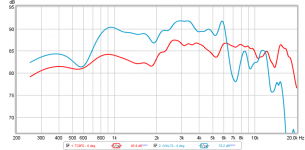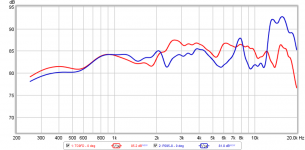Also the earlier graphs are still good and everything is compared under the same conditions. Cut it any way you like, the vifa tc9 is the standout performer at any price point.
Thank you X for bringing the truth forward.
Thank you X for bringing the truth forward.
re: wonky driver = maybe X can send it back for exchange? - if the second driver measures similar then perhaps its just the way its made. If there's any owners of a CHN70 who can measure, then they could help.
X's metrics although limited, I assume were conducted with fixed mic and speaker placements and fixed drive so should be better than nothing to see raw extension. I think he gave a good and honest try.
there have been many a mediocre to horrid sounding speaker to produce a flat enough line.
guess its up to the individual listener.
its not much fun to never get anywhere with this measurement stuff and those waterfall plots give me a headache. There are little speakers which have a nice impulse plot on a "click" which will not ever play a drumkit's snare much less a kick drum or floor tom at realistic levels. (as if those are good in a living room) I like speakers which sound "good" 😀
X's metrics although limited, I assume were conducted with fixed mic and speaker placements and fixed drive so should be better than nothing to see raw extension. I think he gave a good and honest try.
there have been many a mediocre to horrid sounding speaker to produce a flat enough line.
guess its up to the individual listener.
its not much fun to never get anywhere with this measurement stuff and those waterfall plots give me a headache. There are little speakers which have a nice impulse plot on a "click" which will not ever play a drumkit's snare much less a kick drum or floor tom at realistic levels. (as if those are good in a living room) I like speakers which sound "good" 😀
A good CSD is very useful in helping dig out ring-down behaviour, reflections etc. It really needs to have a time scale in periods, the more oft seen msec time scale ones are VERY hard to interpret.
And 30-40 dB depth would be much more useful (25 dB seems common).
And i wish someone would come up with an interactive 3D graph that you could at least rotate.
dave
I've never posted a CSD plot for exactly this reason. I believe to do them right, you need an extremely quite outdoor environment. Ya right. Pretty much impossible. But you need data down to 100hz with a 50db scale, and the Z axis (time) should not be so extended that everything looks clean after several slices. Each scale needs to be set carefully. And to get the Y scale clean 50db down you need a very quite place. To get the X scale down to 100hz you need to be 10ft off the ground. Needless to say, I've never done it to my satisfaction. I do think a lot can be gleaned from a measurement like that though. If you can do it down to 50hz you could possibly identify "muddy" bass. Also "shouty" treble. "Smeared" mids. Etc.
I think he gave a good and honest try.
He can be applauded for that.
dave
Cut it any way you like, the vifa tc9 is the standout performer at any price point.
Have you heard a pair?
dave
Those 1m graphs are throw aways. I think xrk knows that. He needs to adjust the gate. No big deal. But conclusions shouldn't be drawn from them right now. If xrk saved the file, it's easy to change to 3ms.
I saved the data files but I just repeated the measurements at 0.5m with 4ms gate, padding blankets on floor and covered microphone tripod legs with blanket as well. The IR's are clean as a whistle with no reflections out to 6ms+. I also took polars while I was at it. as you can imagine, I have a ton of data now. Will be posting them soon.
Polar Data from 0.5m with 4ms gate
I decided to repeat the measurements at 0.5m distance with a 1ms (pre t=0) and 3ms (post t=0) for a total 4ms gate (250Hz resolution). I reduced the drive level by -6dB so the measured sensitivity is comparable to a 1m measurement at 2.83v. I added blankets to absorb some of the floor reflections and the tripod legs. While I was at it, I took data at 4 different angles: 0 deg, 15 deg, 30 deg, and 45 deg so that we can get a sense of the off-axis behavior. I am plotting everything on 5dB scale (except for RS100P-4 and CHN-70 which needed 10dB/div to show extent of variation) with 1/24th octave smoothing. The lowest resolvable frequency is 250Hz. The measurements are now reflection free (no more combing).
Here is one Impulse Response from the TC9FD at 0 deg just to verify that the IR is clean and reflection free:
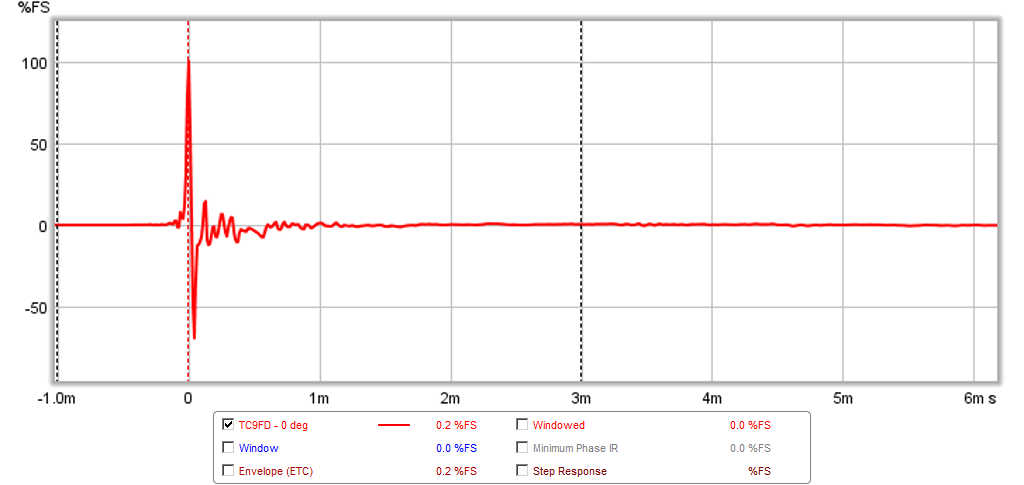
Here are the Polars...
TC9FD:
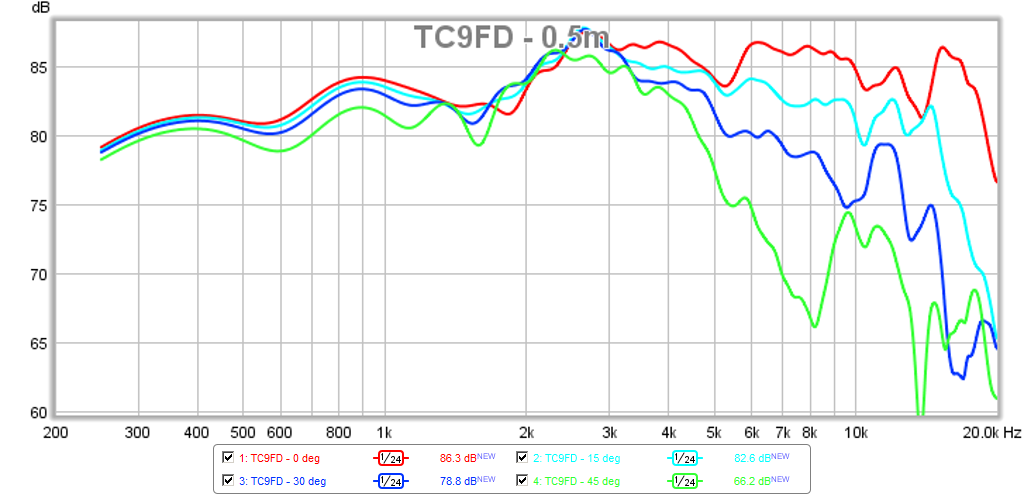
3FE22-4:
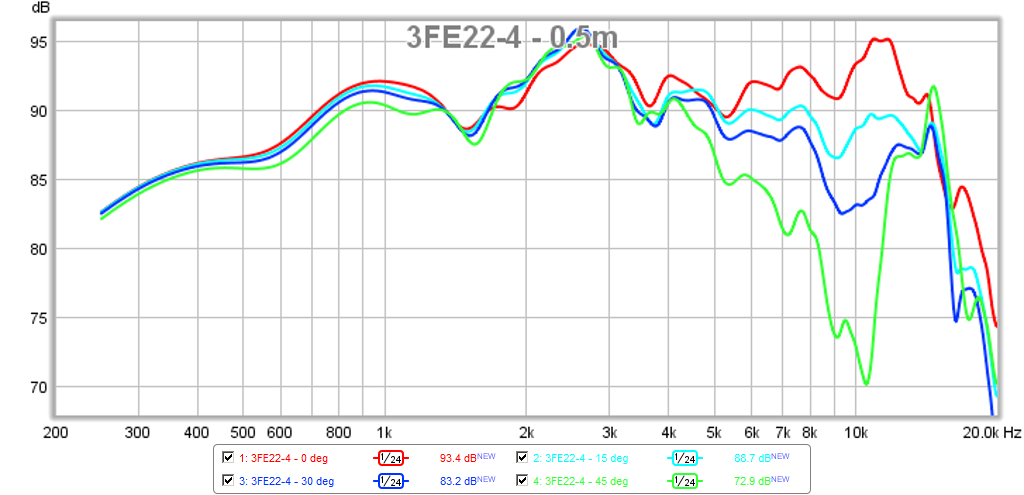
3FE22-16:
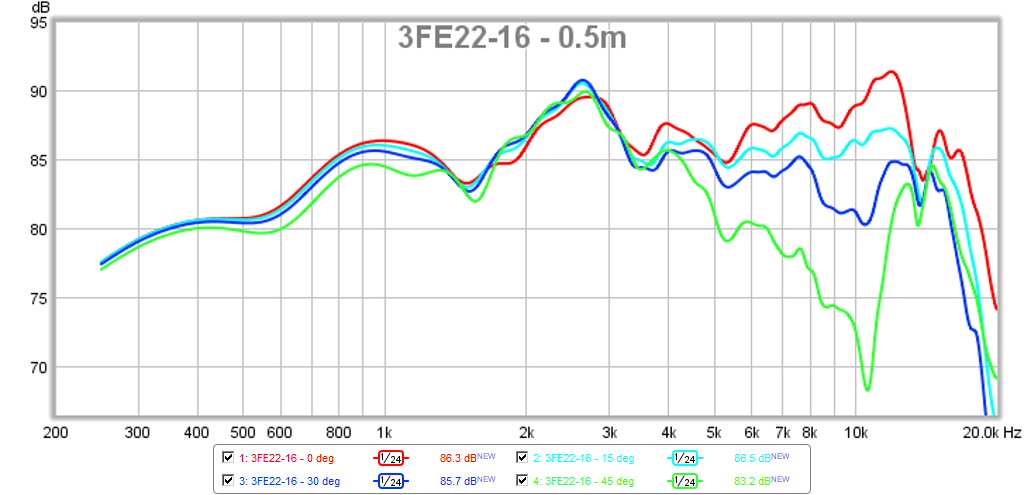
RS100-4:

RS100P-4 (note vertical scale is 10dB/div):
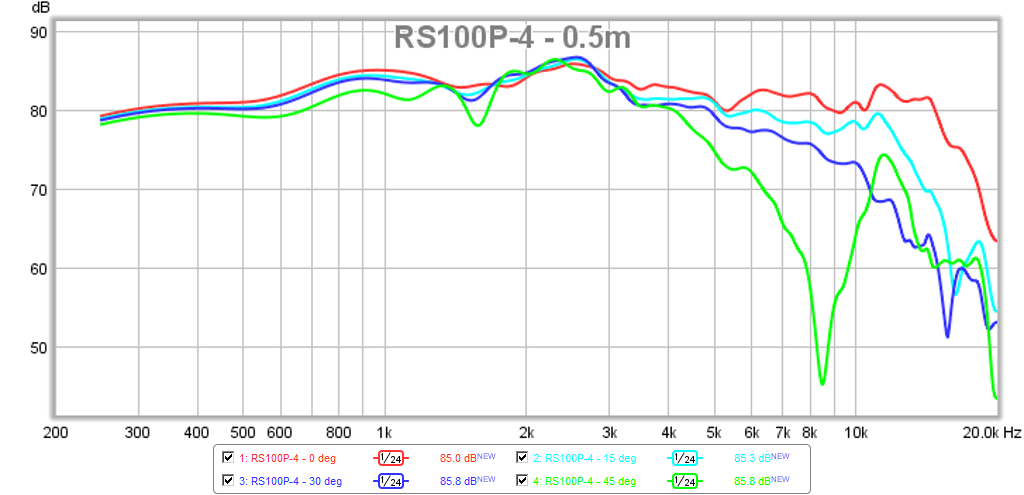
CHN-70 (note vertical scale had to be increased to 10dB/div to accommodate the large variation):
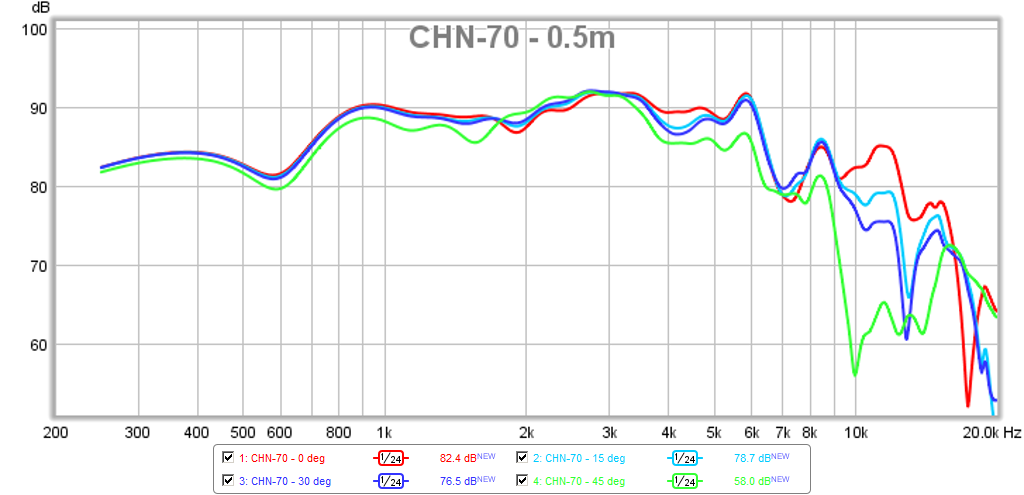
PS95-8:
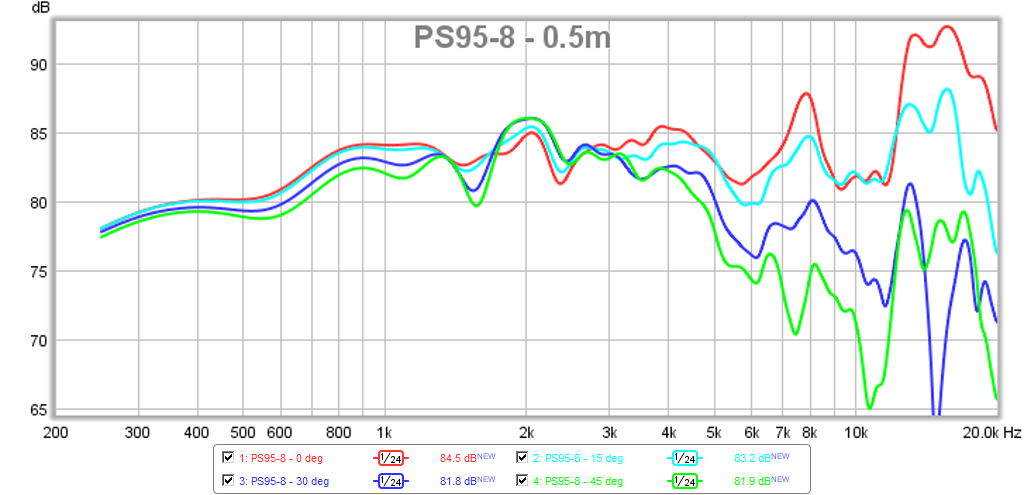
As you can see, repeating the measurement with the correct gate and distance from mic to avoid reflections still produced the same response in the CHN-70 with a sharp edged plateau from 600Hz to 7kHz.
I decided to repeat the measurements at 0.5m distance with a 1ms (pre t=0) and 3ms (post t=0) for a total 4ms gate (250Hz resolution). I reduced the drive level by -6dB so the measured sensitivity is comparable to a 1m measurement at 2.83v. I added blankets to absorb some of the floor reflections and the tripod legs. While I was at it, I took data at 4 different angles: 0 deg, 15 deg, 30 deg, and 45 deg so that we can get a sense of the off-axis behavior. I am plotting everything on 5dB scale (except for RS100P-4 and CHN-70 which needed 10dB/div to show extent of variation) with 1/24th octave smoothing. The lowest resolvable frequency is 250Hz. The measurements are now reflection free (no more combing).
Here is one Impulse Response from the TC9FD at 0 deg just to verify that the IR is clean and reflection free:

Here are the Polars...
TC9FD:

3FE22-4:

3FE22-16:

RS100-4:

RS100P-4 (note vertical scale is 10dB/div):

CHN-70 (note vertical scale had to be increased to 10dB/div to accommodate the large variation):

PS95-8:

As you can see, repeating the measurement with the correct gate and distance from mic to avoid reflections still produced the same response in the CHN-70 with a sharp edged plateau from 600Hz to 7kHz.
Attachments
-
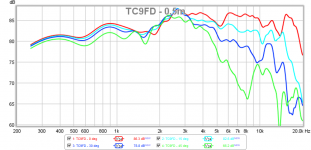 tc9fd-polars-0.5m-4ms-gate.png102.6 KB · Views: 6,689
tc9fd-polars-0.5m-4ms-gate.png102.6 KB · Views: 6,689 -
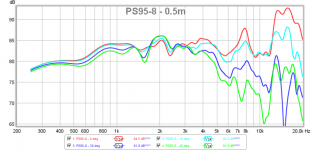 ps95-8-polars-0.5m-4ms-gate.png108.1 KB · Views: 2,699
ps95-8-polars-0.5m-4ms-gate.png108.1 KB · Views: 2,699 -
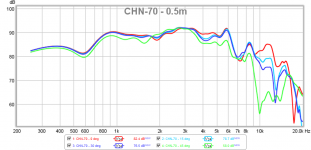 chn-70-polars-0.5m-4ms-gate.png93 KB · Views: 933
chn-70-polars-0.5m-4ms-gate.png93 KB · Views: 933 -
 rs100p-4-polars-0.5m-4ms-gate.png90.3 KB · Views: 935
rs100p-4-polars-0.5m-4ms-gate.png90.3 KB · Views: 935 -
 rs100-4-polars-0.5m-4ms-gate.png97.5 KB · Views: 1,263
rs100-4-polars-0.5m-4ms-gate.png97.5 KB · Views: 1,263 -
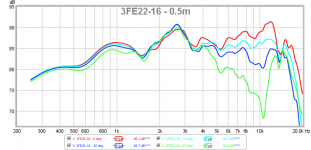 3fe22-16-polars-0.5m-4ms-gate.png99.6 KB · Views: 2,451
3fe22-16-polars-0.5m-4ms-gate.png99.6 KB · Views: 2,451 -
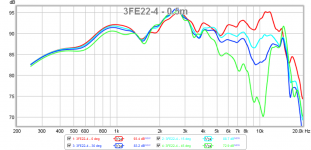 3fe22-4-polars-0.5m-4ms-gate.png102.2 KB · Views: 1,267
3fe22-4-polars-0.5m-4ms-gate.png102.2 KB · Views: 1,267 -
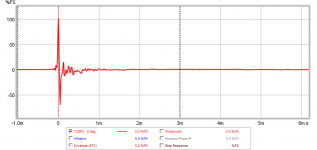 tc9fd-0.5m-ir.png39.8 KB · Views: 976
tc9fd-0.5m-ir.png39.8 KB · Views: 976
Last edited:
cool !! - would you mind sometime posting RS100P-4 and CHN-70 again but with 5dB per vertical division?
Corresponding Impulse Response at 0.5m
Here are the corresponding IR's measured at 0.5m away and 0 deg. I am missing the 3FE22-4 as I forgot to save the data file.
TC9FD:

3FE22-16:
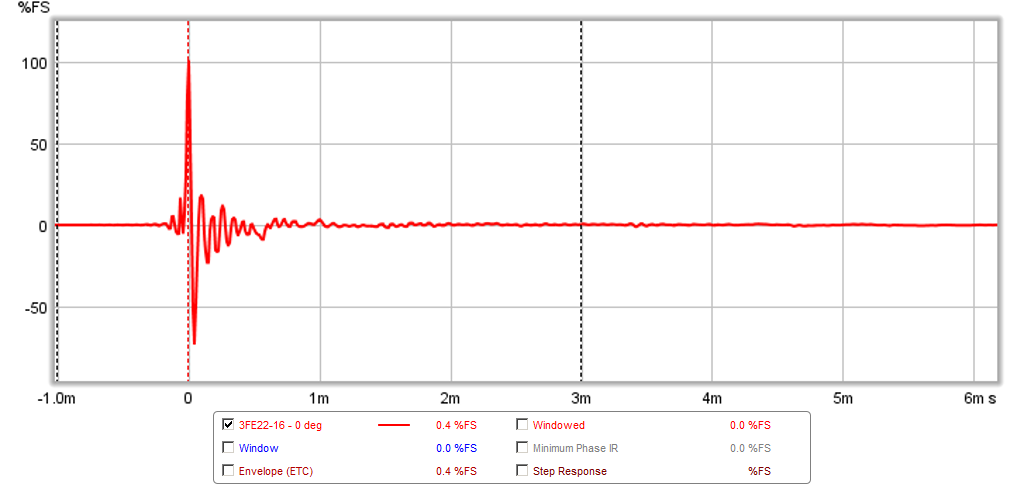
RS100-4:
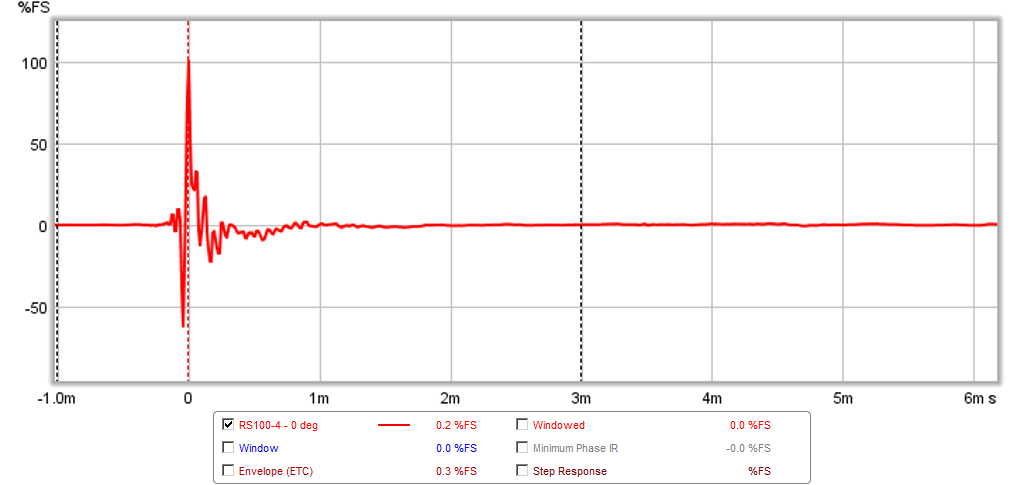
RS100P-4:

CHN-70:
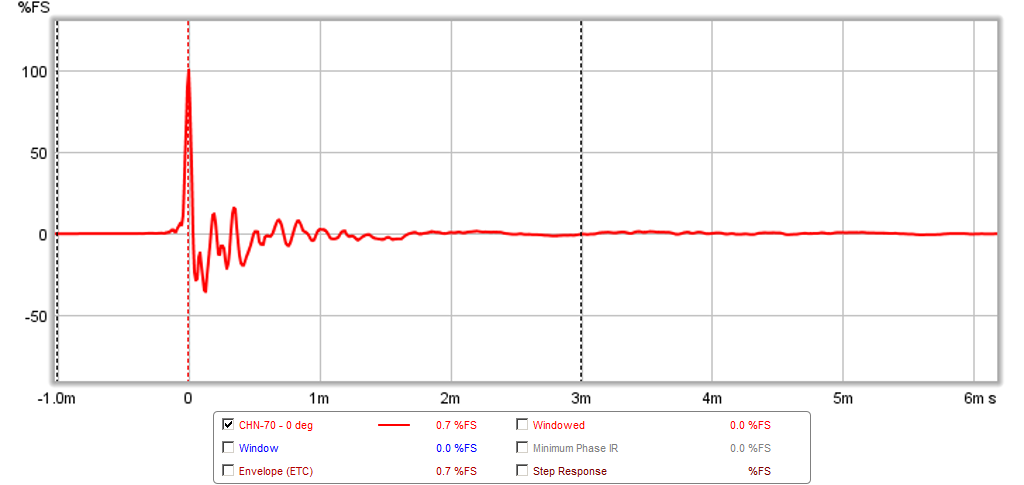
PS95-8:
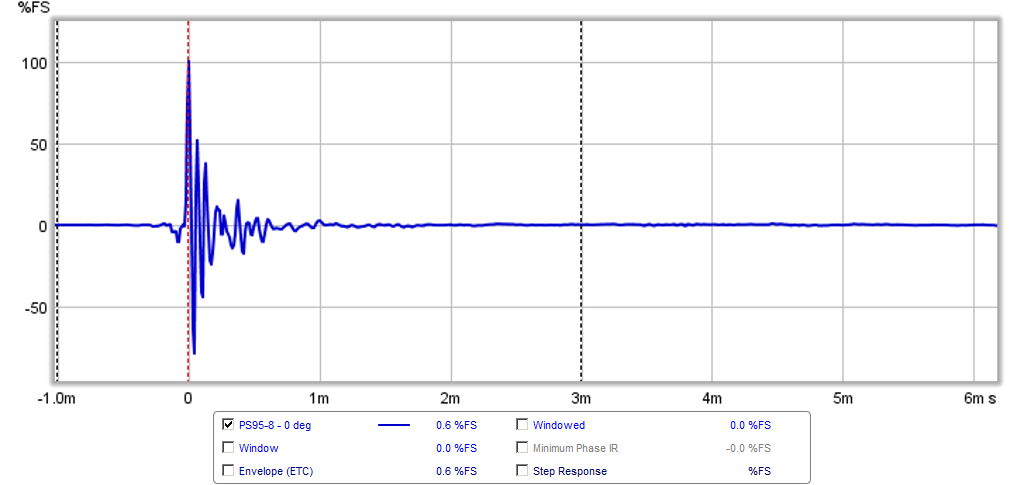
Here are the corresponding IR's measured at 0.5m away and 0 deg. I am missing the 3FE22-4 as I forgot to save the data file.
TC9FD:

3FE22-16:

RS100-4:

RS100P-4:

CHN-70:

PS95-8:

Attachments
Last edited:
Harmonic Distortion
TC9FD
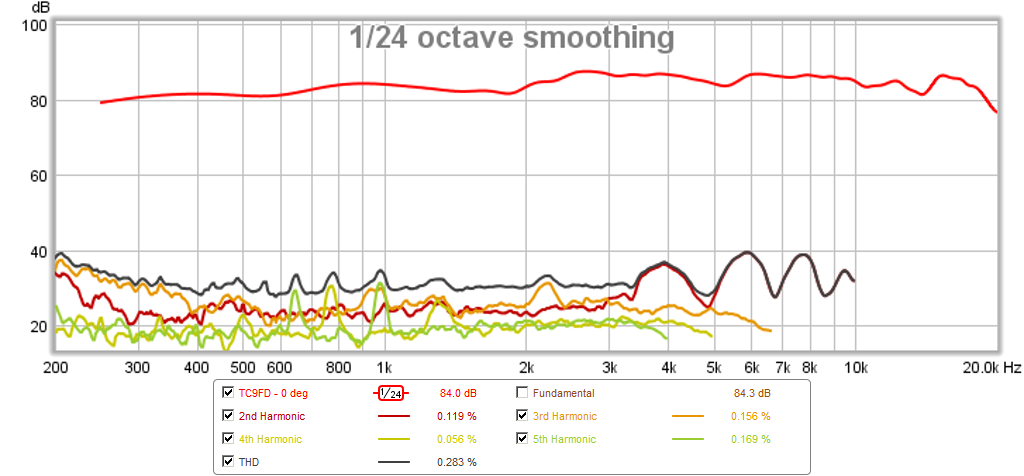
3FE22-16
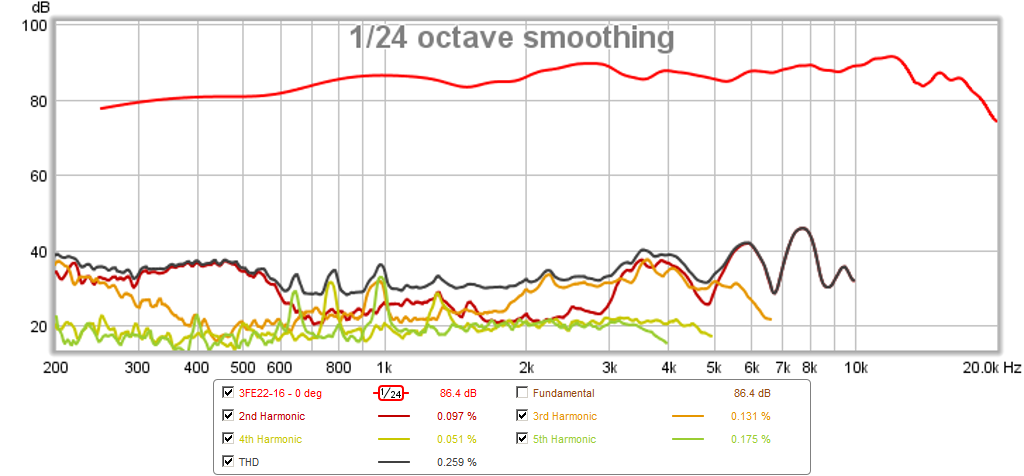
RS100-4
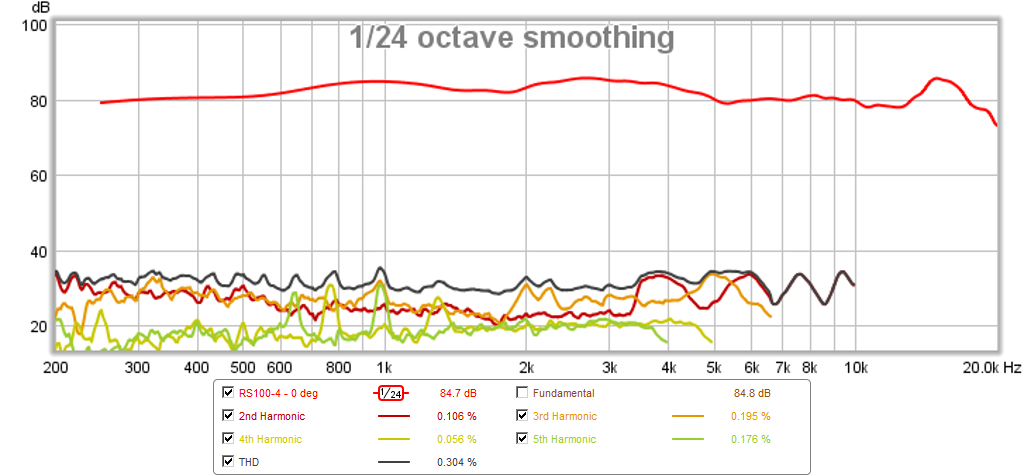
RS100P-4
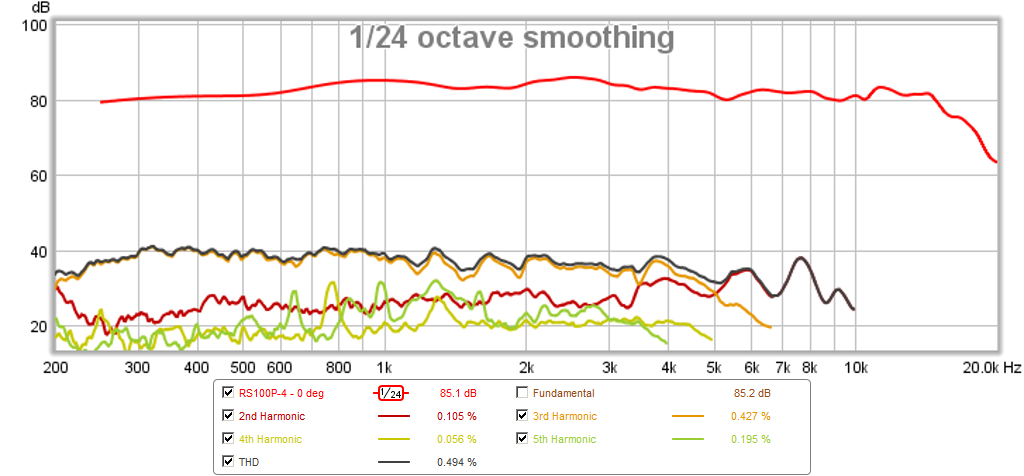
CHN-70 (watch out for the high disotortion peak around 700Hz):

PS95-8
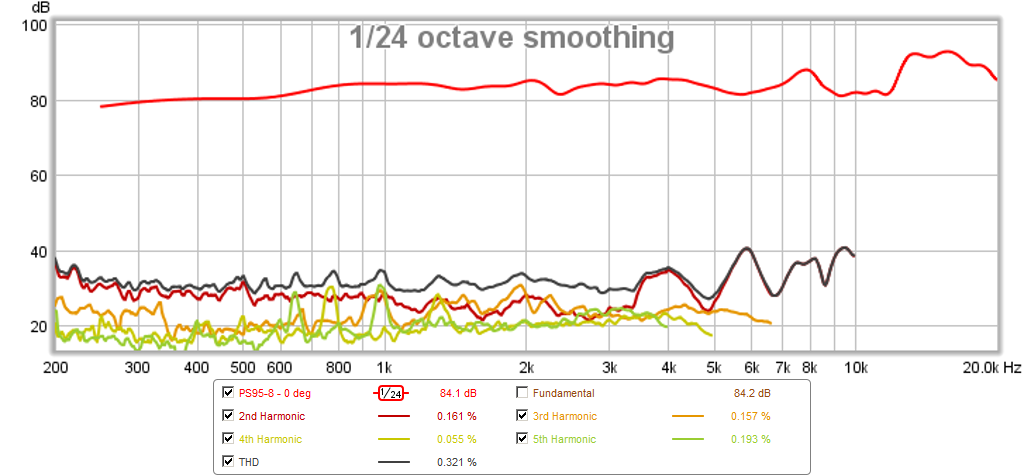
TC9FD

3FE22-16

RS100-4

RS100P-4

CHN-70 (watch out for the high disotortion peak around 700Hz):

PS95-8

Attachments
-
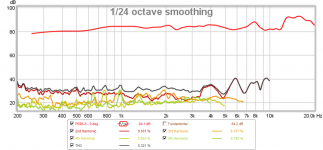 ps95-8-hd-0.5m-4ms-gate.png110.5 KB · Views: 923
ps95-8-hd-0.5m-4ms-gate.png110.5 KB · Views: 923 -
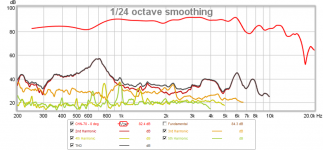 chn-70-hd-0.5m-4ms-gate.png118.1 KB · Views: 935
chn-70-hd-0.5m-4ms-gate.png118.1 KB · Views: 935 -
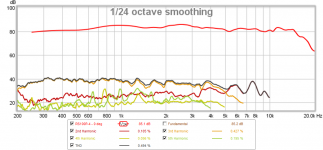 rs100p-4-hd-0.5m-4ms-gate.png110.4 KB · Views: 929
rs100p-4-hd-0.5m-4ms-gate.png110.4 KB · Views: 929 -
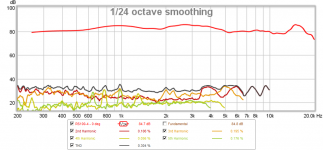 rs100-4-hd-0.5m-4ms-gate.png109.3 KB · Views: 923
rs100-4-hd-0.5m-4ms-gate.png109.3 KB · Views: 923 -
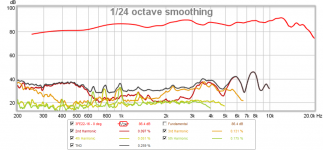 3fe22-16-hd-0.5m-4ms-gate.png112.9 KB · Views: 927
3fe22-16-hd-0.5m-4ms-gate.png112.9 KB · Views: 927 -
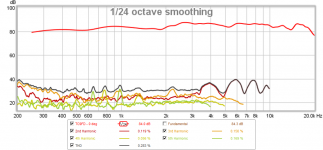 tc9fd-hd-0.5m-4ms-gate.png110.1 KB · Views: 936
tc9fd-hd-0.5m-4ms-gate.png110.1 KB · Views: 936
Comparison of Response vs TC9FD at 0.5m and 0 deg
This is with 4ms gating same as above data.
TC9FD vs 3FE22-16:
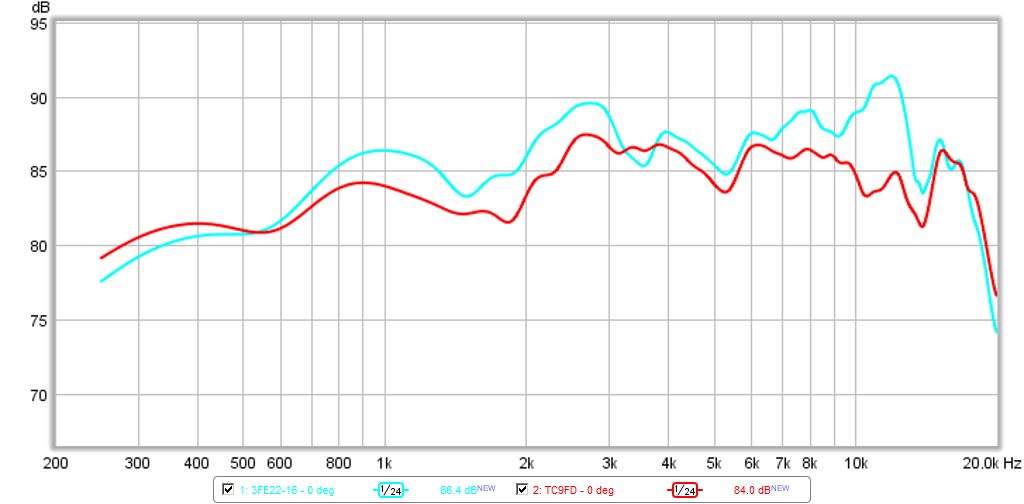
TC9FD vs RS100-4:
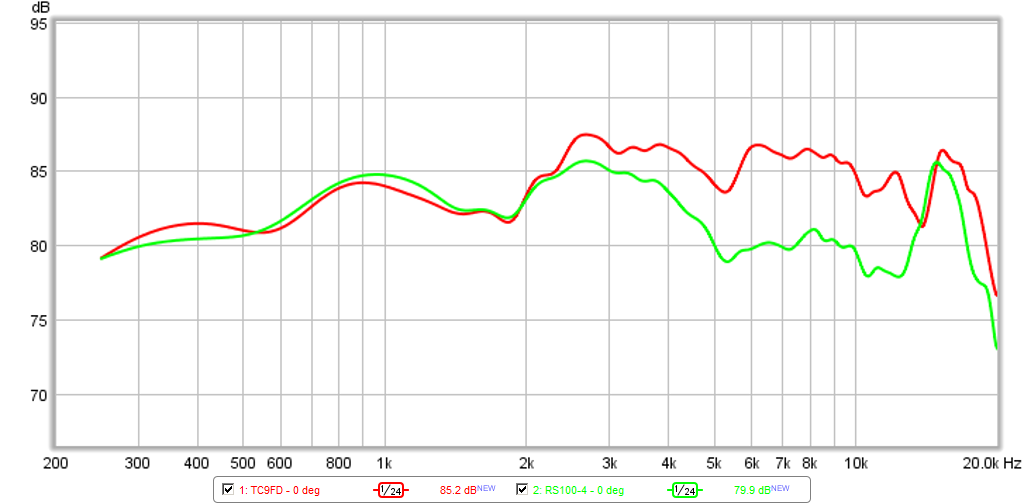
TC9FD vs RS100P-4:
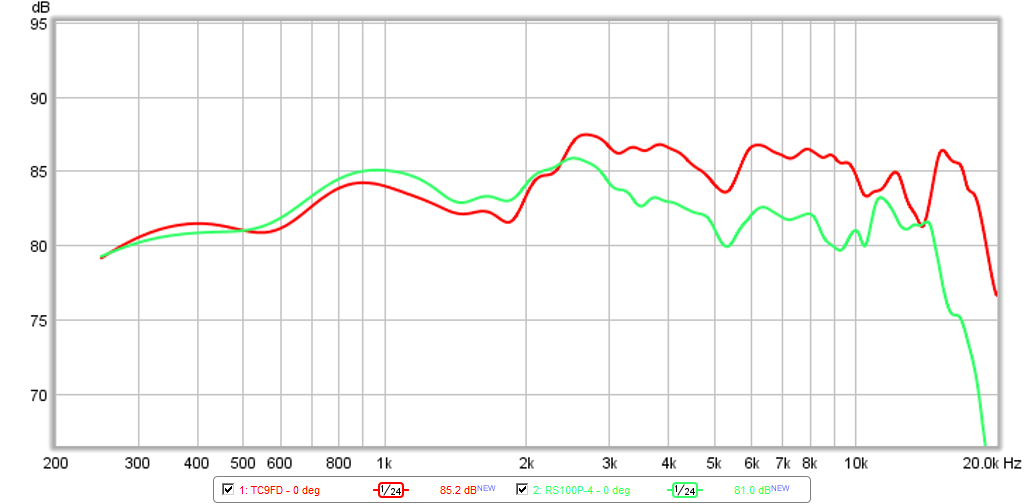
TC9FD vs CHN-70 (response still has issues even with correct gating and far field mic placement):
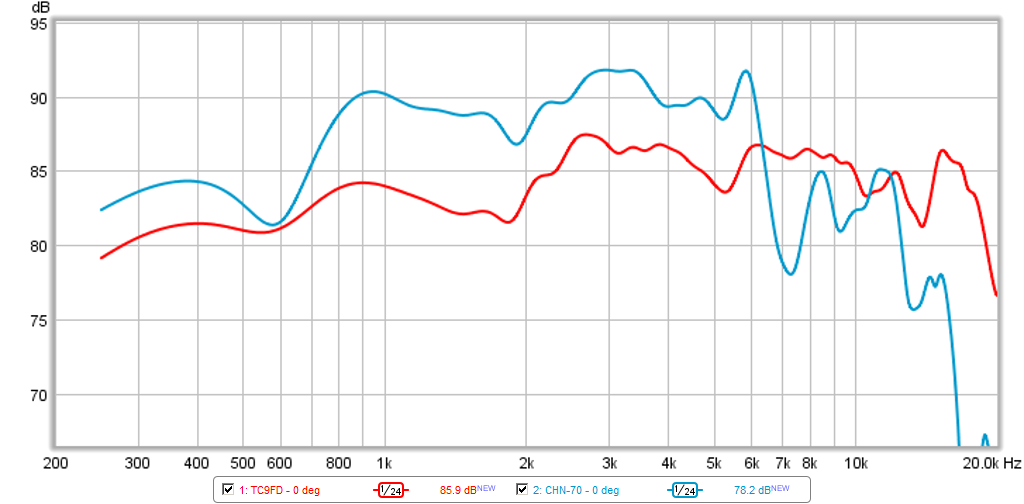
TC9FD vs PS95-8:

This is with 4ms gating same as above data.
TC9FD vs 3FE22-16:

TC9FD vs RS100-4:

TC9FD vs RS100P-4:

TC9FD vs CHN-70 (response still has issues even with correct gating and far field mic placement):

TC9FD vs PS95-8:

Attachments
Last edited:
True, but that one is so wonky, if i were X i'd be embassed to show it, except for the purpose of getting help figuring out what i was doing screwy.
dave
The only thing screwy is the wonky response of the CHN-70. These are new reflection-free measurements at 0.5m with 4ms gating.

Impedance differences will probably be exaggerated somewhat by the load dependant behavior of the amplifier used
something wrong with your testing. I'm listening to CHNs and there's no way they drop off so much around 6khz. I bought them from reading Jim Shearer's review. He seems fair minded to me. CHN is a 6 ohm driver.
Jim's post 46 helped me decide, and the good price... http://www.diyaudio.com/forums/full-range/262520-chn-70-breaking-5.html
something wrong with your testing. I'm listening to CHNs and there's no way they drop off so much around 6khz. I bought them from reading Jim Shearer's review. He seems fair minded to me. CHN is a 6 ohm driver.
At this point, it would seem hard to claim there is anything wrong with the testing. We're now at the "you can't measure what makes these so great" chapter in the never ending story of measurements and MarkAudio drivers...
Anyway... Your comment reminds me of a story:
I had a vintage pair of speakers. They had bad tweeters that were originally crossed at 8kHz. I replaced the tweeters and rebuilt the crossover. Everyone who heard them immediately afterward commented on how wonderful they sounded: Wow that sounds great! Wonderful highs! Listen to all that air! So spacious!
As it turns out, I had botched the crossover. The tweeters had no output. But we were all primed to hear it, and by god, we all heard that tweeter in all its glory.
So...are you going to trust the measurements, or your lying ears?
With the plethora of home testers, (new and experienced), within the DIYAudio community can we not repeat These tests, (with their prefered test method), with say just the chn to rule out any driver defects?
The pyschoacoustics of high audible frequencies is complicated... Even when a signal is down ~5 or ~10dB (above 6khz) it might be perceived as balanced or smooth sounding. I'm probably repeating everyone's sentiment here but pleasant sounding and accurate have always been different goals and the art speaker design is in how well these two characteristics can be married.
Studio monitors err on the side of accuracy so that mix decisions (eq and comp) can be made that will translate well when listened to on both mastering grade kit and consumer garbage. Some studio monitors with flat responses sound great and others not so much. Why this is, is complicated and could be due to ringing/smear, IMD, re-modulation from enclosure reflection, diffraction effects or a hyper-dimensional as yet unproven concept like darksound. DDR?
But in seriousness that particular MarkAudio driver might sound pleasing, but I wouldn't mix records on it > even if I liked how it sounded. A microscope with smudges on the lense isn't terribly useful, because you can guess at what you're not seeing but you won't always be right.
I would rather start with a flat response and shelve it down via DSP *or* enclosure/waveguide until I found it pleasant at my listening position rather than compensate with sharp boosts for large near octave wide gorges.
Very much appreciate X's measurements and the ongoing discussion.
Studio monitors err on the side of accuracy so that mix decisions (eq and comp) can be made that will translate well when listened to on both mastering grade kit and consumer garbage. Some studio monitors with flat responses sound great and others not so much. Why this is, is complicated and could be due to ringing/smear, IMD, re-modulation from enclosure reflection, diffraction effects or a hyper-dimensional as yet unproven concept like darksound. DDR?
But in seriousness that particular MarkAudio driver might sound pleasing, but I wouldn't mix records on it > even if I liked how it sounded. A microscope with smudges on the lense isn't terribly useful, because you can guess at what you're not seeing but you won't always be right.
I would rather start with a flat response and shelve it down via DSP *or* enclosure/waveguide until I found it pleasant at my listening position rather than compensate with sharp boosts for large near octave wide gorges.
Very much appreciate X's measurements and the ongoing discussion.
Jim's post 46 helped me decide, and the good price... http://www.diyaudio.com/forums/full-range/262520-chn-70-breaking-5.html
I too, respect Jim Shearer's opinions - he has built several of my speaker designs. He did mention a rather rolled off high end which is consistent with the measurement. Given that the CHN-70 was measured in the same setup and at same time as 6 other drivers, I am quite certain the measurement is not to blame. It may be perhaps a defective drive unit and I am actually thinking of requesting a replacement from the distributor. Because frankly, in its current state, I can't use it.
In the thread where JS recommends the CHN-70, no measurements are posted but further on in that same thread, post #55, JS says,
And in the end, as a (retired) analytical chemist, I still hold to our slogan:
"One measurement is worth a thousand expert opinions."
Cheers, Jim
Impedance differences will probably be exaggerated somewhat by the load dependant behavior of the amplifier used
Hi Irribeo,
Good to see you over here from the TPA3116 thread. I am using one of DUG's original (pre-GB) TPA3116D2 amps to drive the test. I measured the impedance of the CHN-70 in the Nautaloss and the impedance has a rounded bump varying from about 5ohms to 13ohms - not a big peak by any means and probably within the ability of the TPA3116D2 to drive with sufficient authority.
Here is the measured impedance sweep shown in post #1:
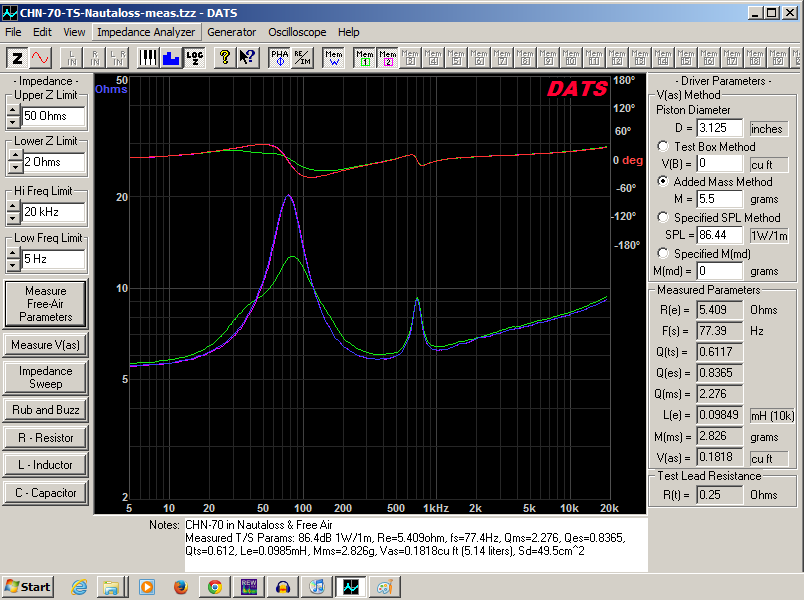
- Status
- Not open for further replies.
- Home
- Loudspeakers
- Full Range
- An Objective Comparison of 3in - 4in Class Full Range Drivers
